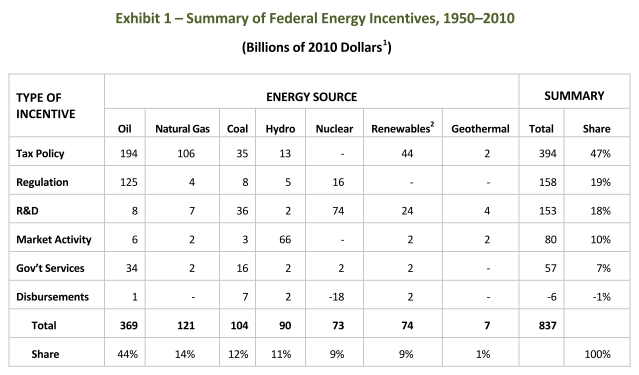In recent years, energy subsidies have risen to become a first-tier political issue. Lots of folks are thinking and talking about them, which is absolutely a Good Thing. However, the discussion has remained narrow and legalistic in a way that obscures some larger realities.
The usual question that gets asked is, who gets more direct subsidies — fossil-fuel industries or renewables industries? The answer to that question can be found in an updated report from consultancy Management Information Services Inc., which tries to tally up every kind of direct subsidy — tax credits, regulation, R&D money, etc. — from 1950 to 2010. The verdict:
 “60 Years of Energy Incentives: Analysis of Federal Expenditures for Energy Development,” MISI
“60 Years of Energy Incentives: Analysis of Federal Expenditures for Energy Development,” MISI
Obviously fossil fuels have gotten the bulk of government help — 70 percent to renewables’ 10 percent, for a total of $594 billion in fossil-fuel subsidies over the last 60 years.
I’m not going to say those subsidies don’t matter. They absolutely do, and they’re worth fighting. Nonetheless, I worry that this kind of bean counting radically understates the fossil fuels’ built-in advantages. It exaggerates the importance of direct subsidies to fossil fuels and makes greens think that if they can just “end energy subsidies,” renewables will have a fair shot at competing. In fact, renewables are much, much more reliant on direct subsidies than fossil fuels.
The problem with tallying up direct subsidies is that it misses the two greatest sources of public support for fossil fuels, both of which are indirect, both of which dwarf direct subsidies.
The first and greatest indirect subsidy is the tab that the public picks up for the external costs fossil fuels impose. These include the extraordinary public health costs of air and water pollution. (A recent analysis from respected economists found that coal-generated electricity imposes more in public health costs than the electricity is worth on the market.) There are the national security costs of reliance on oil, which account for at least some portion of the estimated $3 trillion cost of the Iraq and Afghanistan wars, and which have compelled the U.S. military to try to end its oil addiction.
And of course there are the costs of climate change. These are notoriously difficult to calculate, but there’s good reason to think the “social cost of carbon” being used by the U.S. government to calculate damages from climate change is radically understating the danger. Or, put another way, it is radically underestimating the public subsidy to greenhouse-gas-emitting industries.
The second big indirect subsidy is to demand for fossil fuels, which has been locked in by a century’s worth of massive and ongoing infrastructure spending. Energy analyst Chris Nelder had a fantastic piece on this last week. Using some rough and ready calculations, he tries to tally up the total “sunk costs” represented by U.S. transportation infrastructure — highways, airports, and all. He finds:
In sum, the U.S. has already spent over $6 trillion in direct costs for transportation infrastructure, not including a good deal of associated infrastructure and land values, and not fully accounting for replacement costs in 2011 dollars. (If I had to guess, I’d peg the current present value of all of it at perhaps double that: $12 trillion.) The mere existence of that infrastructure, which is to say our complete dependence on it, means that we’re already committed to spending at least $1.6 trillion additional dollars per year in maintenance, new vehicles, and fuel (leaving out the associated costs, like military expenditures). Again, the real numbers, if we had them, would be substantially larger.
That kind of money makes $594 billion over 60 years look like pocket change. For every dollar we spend maintaining and building new car-and-highway-centric infrastructure, we lock in demand for oil.
That’s why the biggest lobby perpetuating U.S. oil dependence is not the oil companies themselves but America’s ARSE (auto/road/sprawl empire), which is larger and, as energy analyst Gregor Macdonald notes, spread throughout all 50 states. And while there have been murmurs about going after direct subsidies to fossil fuels, virtually no one in U.S. government — in either party — is willing to do more than nibble around the edges of the ARSE. (Okay, I’m rethinking that acronym.) Cars are king for Obama too.
As Nelder says, our entire $6 trillion infrastructure was built around the assumption of cheap oil. It is utterly unsuited to a world of peak oil and climate pressure. Forgive me as I quote him at length:
In this context, the current debate over energy subsidies seems entirely misbegotten. What’s the point in arguing over some $4 billion per year in oil industry subsidies (which I have long opposed) when we’re already on the hook for $1.6 trillion per year to remain with our current transportation regime? …
This context also demonstrates why the US High Speed Rail Association’s newly-updated $600 billion price tag for a system that would cover all our major metropolitan cities is decidedly cheap. The $40 billion or so we’ve spent on Amtrak is peanuts. Who wouldn’t think it makes sense to spend a bit more than one-third of our existing annual transportation commitment to permanently retire a substantial portion of our unsustainable air and road traffic?
Instead of incremental spending on an effectively dead transportation regime, we should be thinking about one that can survive the challenges ahead, and deliver more economic benefits than costs. We should be setting an ambitious target, like replacing all commercial passenger air flights with high speed rail for trips under 1,000 miles, replacing 90 percent of our city street traffic with light rail, and moving all long-haul freight traffic to rail. Even if the cost of all that rail infrastructure were in the range of $3 trillion, it would be a fantastic investment.
… Would you rather spend another $32 trillion over the next 20 years just to maintain our outmoded, unscalable, aged, unhealthy system, plus another $2.8 trillion in lost productivity due to delays and gridlock, only to wind up out of gas? Or would you rather spend $25 trillion to repair our existing infrastructure, transition transportation to rail, transition the power grid to renewables, upgrade the entire grid, and solve the carbon problem, to have free fuel forever?
I can’t say it better than that. I’ll just add that while Nelder focuses on transportation, the same basic political-economy framework applies to electricity. We built our houses and industries on the assumption of cheap electricity; those practices, codes, and regulations are still embedded in our construction and manufacturing sectors. We built our power transmission lines on the assumption of large, remote power plants. Coal has plenty of lobbying muscle in its own right, but it’s nothing compared to the heavy lifting that utillites, heavy industry, and construction & manufacturing industries do for it.
The simple fact is that modern industrial society was built by, around, and for fossil fuels. The assumption of cheap, concentrated sources of energy is embedded into all of our institutions and practices. Maintaining our status quo industrial infrastructure — a cost that absolutely dwarfs direct subsidies to fossil fuels — is an investment in fossil-fuel dominance. And we pay it every year, even as we pay the rising costs it imposes on us.
Viewed in this light, fossil fuels and renewables are not really “competing” on some common “playing field.” Fossil fuels built the field; it is designed for their game. Renewables don’t just have to produce energy at competitive prices, they must bring along with them new applications, new infrastructure, new institutions and practices. To switch from fossil fuels to renewable energy is not like going from Coke to Pepsi; it is to build a new world.
Comparisons of direct subsidies capture only the tip of a giant iceburg — most of fossil fuels’ big advantages are invisible, beneath the surface, and entirely taken for granted.



